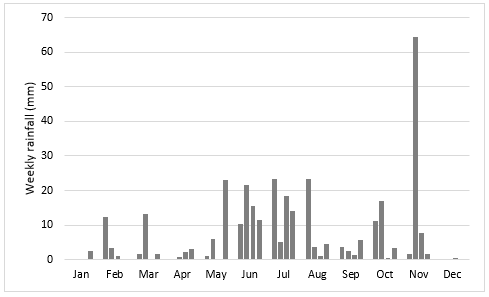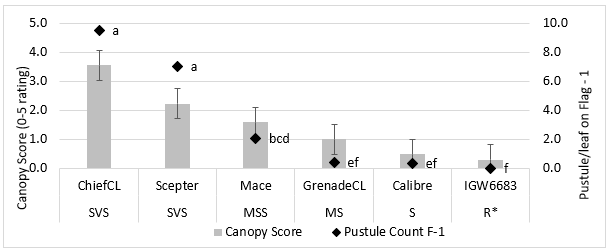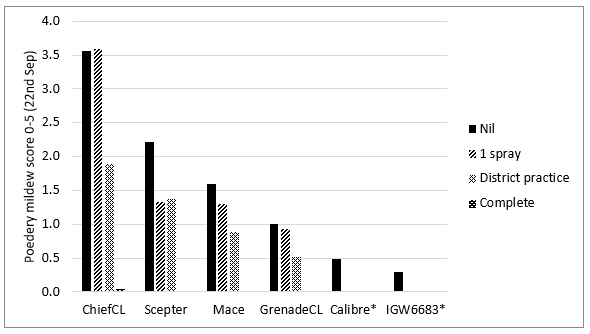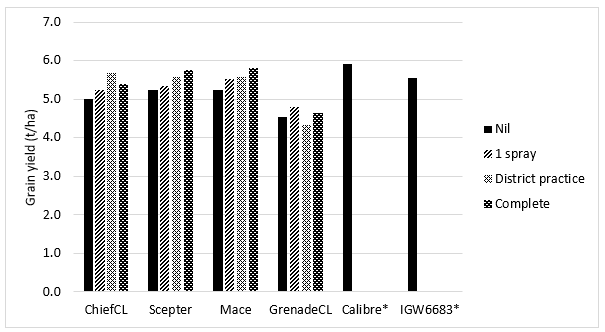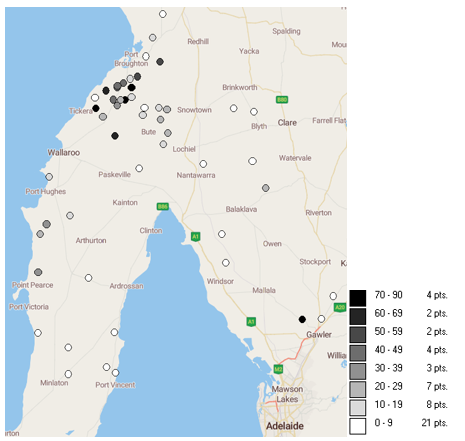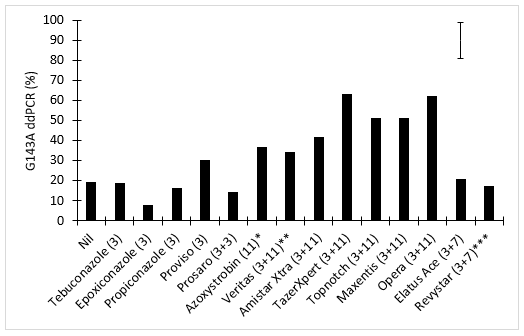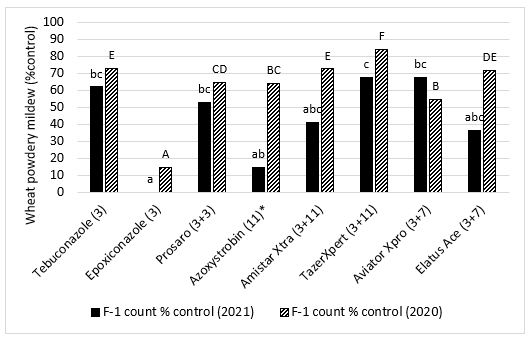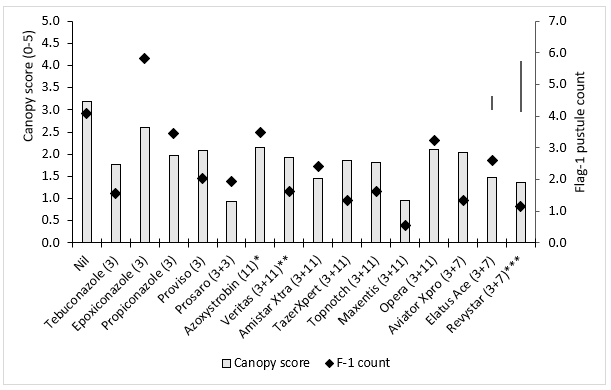Fungicide resistant wheat powdery mildew – management and resistance testing
Author: Sam Trengove, Stuart Sherriff & Jordan Bruce (Trengove Consulting) and Fran Lopez Ruiz & Kejal Dodhia (Centre for Crop and Disease Management, Curtin University, Perth) | Date: 22 Feb 2022
Take home messages
- Varietal resistance plays an important role in managing wheat powdery mildew. The variety Grenade CL PlusA (MS) had less powdery mildew infection in the untreated than Chief CL PlusA and ScepterA (SVS) treated with a two-spray fungicide strategy.
- Wheat powdery mildew resistance mutation frequency increased from 2019 to 2021. In the northern Yorke Peninsula region in 2019, more than half the paddocks surveyed had no group 11 QoI (strobilurin) resistance mutation, whereas in 2021, all 30 paddocks sampled had some level of resistance mutation with the median resistance frequency increasing from 0 to 19%.
- Group 11 QoI resistance mutation has been detected at lower levels in the central Yorke Peninsula and Mid North regions in 2021.
- In a fungicide product trial, the application of group 11 QoI fungicides increased the frequency of resistance mutation from 19% in the untreated control to 48.5% on average across QoI treatments.
- The presence of group 11 resistance mutations meant that the performance of group 3 + 11 fungicide mixtures was generally not any better than the straight group 3 (DMI triazole) fungicides.
- Group 7 SDHI fungicides did not provide any additional control to the standalone group 3 DMI fungicides when applied in product mixtures. This is due to poor efficacy of group 7 fungicides on wheat powdery mildew, with no resistance to this fungicide group identified in these powdery mildew populations.
- Mutation at Cyp51 is a gateway mutation that infers reduced sensitivity to the group 3 DMI fungicides is likely, though the actual mutations conferring resistance are not known. High frequency of the Cyp51 mutation has commonly been encountered at trial sites, yet the group 3 DMI fungicides are currently providing the best fungicidal control, albeit incomplete control.
Background
Wheat powdery mildew (WPM) has been documented to cause up to 25% yield loss in Australia. Wheat varieties that are commonly being grown have poor varietal resistance, with many having ratings of susceptible to very susceptible (SVS), and only a few varieties rated as moderately susceptible to susceptible (MSS) or moderately susceptible (MS). The most common wheat variety grown in the northern Yorke Peninsula area has been ScepterA, which has a SVS rating. Consequently, there is a heavy reliance on foliar fungicides for WPM control. Fungicide options for WPM and other diseases have relied heavily on the DMI group 3 (triazole) products such as tebuconazole and epoxiconazole, and these are the basis of many fungicide mixes, putting pressure on resistance development. In more recent years, there has also been increasing use of the QoI group 11 (strobilurin) actives in mixtures with DMI fungicides in products such as Amistar Xtra® (azoxystrobin + cyproconazole), but control from these fungicides has been variable due to QoI resistance developing in some of the same populations. New generation fungicides which contain a group 7 (SDHI) active ingredient, such as Aviator Xpro and Elatus Ace, were expected to provide improved control of WPM, particularly WPM populations with reduced sensitivity or resistance to group 3 DMI and 11 QoI fungicides. However, findings from 2020 indicate the group 7 SDHI actives have poor efficacy on WPM, with most of the control from these fungicides being derived primarily from the group 3 DMI mix partner (Trengove et al 2021). In terms of fungicide resistance risk the DMI group 3 are medium risk, whilst the SDHI group 7 and QoI group 11 fungicides are medium-high and high risk for development of fungicide resistance (AFREN Fungicide Resistance Workshop), (FRAC Code List ©*2021).
Trials were initiated in 2020 and 2021 as part of SAGIT project TC120 to better understand best practice management of WPM given emerging fungicide resistance issues.
Method
Five trials were established in 2020 (Trengove et al 2021) and six in 2021. Each of the trials had a particular focus and the main varieties used (excluding the variety trial) were ScepterA and Chief Cl PlusA in 2020 and Chief Cl PlusA in 2021. The focus of the 2021 trials were:
- Varietal resistance and post emergent fungicides
Four varieties with disease ratings for WPM ranging from MS to SVS and four fungicide strategies, plus two new lines with no fungicide applied. - Pre-emergent fungicides
Six pre-emergent fungicides +/– post emergent fungicide. - Post-emergent fungicides
A range of post emergent fungicide treatments applied at the full label rate at both, GS32 and GS39. Fungicide rates are described in Appendix 1. - Fungicide timing
Fungicide applied at four timings (GS14, 32, 39 and/or 71) in 10 timing combinations. - Fungicide sequencing
A trial focused on controlling resistant powdery mildew using 12 combinations of pre-emergent and post emergent fungicides from a range of fungicide groups. - Fungicide coverage
A trial investigating the application rate of two fungicides and a control treatment and two water application rates 100 and 200L/ha.
Each trial was a randomised complete block design with three replicates and plots were 10m * 1.5m. Post emergent fungicide treatments were applied using 015110 pre orifice nozzles in 100L of water.
The 2021 trials were located at a site on a sand hill north of Bute, northern Yorke Peninsula, where WPM has been frequently observed. Nearby sites were identified in a 2019 survey with reduced sensitivity to group 3 DMI and resistance emerging to group 11 QoI fungicides. This paper will only present results from the variety and product trials established in 2021 at this site.
Powdery mildew assessments were made during the growing season using either a canopy score of 0 – 5 (0 = no infection, 1 = low infection, 2 = low-moderate infection, 3 = moderate infection, 4 = high infection, 5 = severe infection) or pustule count on specific plant parts. Where pustules merged, an individual pustule was counted as an area of 2mm2. WPM samples were collected from the fungicide product trial on Sept 27 and inserted into a nucleic acid preservation buffer (NAP buffer) to prevent the degradation of the DNA during transport. Three samples were collected per plot, with two WPM infected leaves included in each sample. These were submitted to the Centre for Crop and Disease Management (CCDM) for fungicide resistance testing.
A survey of WPM was collected from the northern Yorke Peninsula (NYP – 30 paddocks), central Yorke Peninsula (CYP – 11 paddocks) and Mid North (MN – 10 paddocks). Agronomists working in these regions supplied location details of WPM infections. Sampling was performed on Sept 23 and 24. Several WPM infected leaves were collected from each location and inserted into the NAP buffer as above. These were submitted to CCDM for resistance testing.
In the NYP region, the 2021 season was characterised by a dry start and late May break, followed by a wet early winter period (Figure 1). The region then experienced a dry late winter and early spring. Wheat powdery mildew developed later in the 2021 season compared with 2020. WPM infection was observed to develop through the latter part of August as the crop approached GS39, whereas in 2020 infection occurred from GS14 in late June. Different seasonal conditions likely explain the differences in disease development between these years.
WPM spores germinate best at high levels of humidity (>95%) with a temperature range of between 10 to 22°C. Disease development will rapidly decline when temperatures exceed 25°C and humidity lowers however spores can still germinate when humidity declines below 50% due to their high moisture content. Under higher rainfall or free moisture conditions (i.e., rainfall) the moisture can both wash the spores from the leaves or inhibit spores from germinating by causing them to burst (Cunfer 2002; Te Beest et al. 2008).
Figure 1. Weekly rainfall at Bute in 2021. April to October rainfall 234mm, 2021 annual rainfall 346mm.
Results and discussion
Varietal resistance to wheat powdery mildew
Varietal resistance is an important part of powdery mildew management. A total of six varieties were included in this trial in 2021 with a range of resistance levels to determine the benefit of varietal resistance and its interaction with fungicide use. The varieties included Grenade CL PlusA (MS), MaceA (MSS), ScepterA (SVS) and Chief CL PlusA (SVS). ScepterA and Chief CL PlusA were both chosen as they have commonly been grown in the area and field observations indicate that Chief CL PlusA may be more susceptible than ScepterA, despite both being rated SVS. Two new lines, Calibre (RAC2721) rated S and IGW6683 with provisional rating of R were also included although no fungicide treatments were applied to these. This was to test their ratings against the WPM population at this site and known commercial cultivars.
Powdery mildew build-up occurred late in the 2021 winter, however, varietal resistance played an important role in the level of infection in the crop canopy (Figure 2). For the four main varieties, increasing the rating from SVS (Chief CL PlusA) to MS (Grenade CL PlusA) reduced the number of pustules on the leaf flag -1 (F -1) by 96%. CalibreA incurred less WPM infection than expected given its resistance rating, with results at this site placing it between the MS and R varieties, rather than its current S rating. However, WPM has large genetic diversity, with many different pathotypes likely to be encountered across the cropping regions, meaning that varietal resistances can perform differently depending on which pathotype is present. In accordance with its R rating, IGW6683 performed very well at resisting WPM infection. No WPM infection was recorded on this variety at all, except in one small 4m2 hotspot in the 3rd replicate of the trial. In this hotspot infection was observed with average canopy score of 1.5, but no infection on the F -1 on September 22. Tara Garrard and Hugh Wallwork (SARDI) collected a sample of this isolate for culturing and testing in the glasshouse, with their results indicating that where this pathotype is dominant IGW6683 is likely to perform more like an SVS, rather than R. This example highlights the scale of genetic diversity that can be encountered in the field.
Figure 2. Powdery mildew canopy score (0 = no powdery mildew, 5 = severe infection) and pustule count on F-1 (number of pustules on the leaf flag – 1) for the nil fungicide treatments in the variety * fungicide trial at Bute 22/9/2021. Letters denote significant differences between pustule count (Pr(>F) = <0.001) and error bars show LSD 0.05 for canopy score.
Varietal resistance has a significant effect on fungicide performance and their importance. In the variety Chief CL PlusA, which was shown to have the highest level of susceptibility to WPM, a one spray strategy (Amistar Xtra 800mL/ha applied at GS39) did not significantly reduce the canopy score and the district practice treatment (Epoxiconazole125 500mL/ha# applied at GS32 followed by Amistar Xtra 800mL/ha applied at GS39) reduced the infection score to 1.9 (low-moderate) (Figure 3). ScepterA was less susceptible to this WPM population, with the single spray strategy reducing the canopy score of infection from 2.2 (low-moderate) to 1.3 (low). This was equivalent to the district practice treatment. In comparison, the variety tested with the best currently available resistance, Grenade CL PlusA, had a lower canopy score in the nil fungicide treatment than the other varieties that were treated with a two-fungicide strategy, as did CalibreA and IGW6683.
# The label rate of epoxiconazole for control of WPM is 250mL/ha, 500mL/ha was used due to the expected presence of group 3 fungicide reduced sensitivity and to align the active ingredient loading with other products.
The level of powdery mildew in the canopy was lower than the previous year, but some effect on grain yield was still apparent (Figure 4). Grain yields for Chief CL PlusA, ScepterA and MaceA increased by 0.6-0.7 t/ha (11-13%) through the application of fungicide whereas in the more resistant variety Grenade CL PlusA there was no yield response. In 2020 the yield response in Chief CL PlusA was also 0.7t/ha (17%), but at a lower yielding site this was a larger relative increase.
Figure 3. Powdery mildew canopy score (0 = no powdery mildew, 5 = severe infection) in the variety * fungicide trial at Bute 22/9/2021 (Pr(>F) = 0.001, LSD 0.05 = 0.2). Nil = no fungicide, 1 spray = Amistar Xtra 800mL/ha applied at GS39, District practice = Epoxiconaxole125 500mL/ha# applied at GS32 + Amistar Xtra 800mL/ha applied at GS39, Complete = complete control. *Calibre and IGW6683 only received Nil treatment.
Figure 4. Grain yield (t/ha) for the variety * fungicide trial at Bute 2021 (Pr(>F) = 0.001, LSD 0.05 = 0.51). Nil = no fungicide, 1 spray = Amistar Xtra 800mL/ha applied at GS39, District practice = Epoxiconaxole125 500mL/ha# applied at GS32 followed by Amistar Xtra 800mL/ha applied at GS39, Complete = complete control. *Calibre and IGW6683 only received Nil treatment.
Wheat powdery mildew fungicide resistance and post-emergent fungicide performance
Wheat powdery mildew fungicide resistance was confirmed on the northern Yorke Peninsula (NYP) in 2019. The frequency of the gateway mutation at Cyp51, which is used as a resistance marker due to its association with the presence of other mutations conferring reduced sensitivity to the Group 3 DMI fungicides, ranged from 2.2 to 99.5%, while the group 11 (QoI) resistance mutation was up to 57.5% in one paddock, but with more than half of tested paddocks with no QoI resistance mutation (Table 1). A second survey was conducted in 2021 and the geographical spread of mutations associated with fungicide resistance on the central Yorke Peninsula (CYP), NYP and the mid north (MN) was assessed (Figure 5). For the NYP, CYP and MN the average level of the QoI resistance mutation was 32.6, 11.9 and 10.2% respectively with a large range in frequencies in each of the areas (Table 1). It shows that there has been a significant increase in the frequency of this mutation on the NYP since the first survey in 2019. All paddocks tested in this region now record at least a low level of the resistance mutation, and the median has increased from 0 to 19%. This is consistent with QoI resistance development in other pathogens, where once resistant individuals have been selected, resistance development occurs quickly with ongoing QoI fungicide selection pressure. The analysis of the NYP samples revealed a higher frequency of the resistance mutation compared with nearby regions, and this is consistent with anecdotal observations from agronomists where WPM control has been more difficult in this region. Frequencies of the QoI resistance mutation in 2021 on the CYP and MN is more comparable with the levels on the NYP in 2019. These results demonstrate where the CYP and MN might be in two years’ time with ongoing QoI fungicide use. There is a large amount of variability within each region too, as shown by the range from minimum to maximum between paddocks, this may possibly be explained by fungicide applications within individual paddocks, however not all data is currently available for this analysis.
Table 1. Average, median, minimum and maximum frequency of the G143A mutation in the wheat powdery mildew strobilurin (QoI) target Cytb tested using ddPCR for the samples collected from paddocks across the central Yorke Peninsula (CYP), northern Yorke Peninsula (NYP) and the mid north of SA (MN).
Area | # of samples | Average frequency (%) | Median Frequency (%) | Minimum frequency (%) | Maximum frequency (%) |
|---|---|---|---|---|---|
NYP 2019 | 17 | 13 | 0 | 0.0 | 57.5 |
NYP 2021 | 30 | 32.6 | 19.2 | 1.7 | 89.5 |
CYP 2021 | 11 | 11.9 | 4.6 | 0.6 | 38.3 |
MN 2021 | 10 | 10.2 | 0.8 | 0.0 | 89.7 |
Figure 5. Sample locations and frequency of the G143A mutation in the wheat powdery mildew strobilurin (QoI) target Cytb tested using ddPCR for the samples collected for paddocks across the central Yorke Peninsula, northern Yorke Peninsula and the mid north of SA in 2021, number of points in the legend show number of paddocks sampled in that range.
At the 2020 trial site SE of Bute there was low level of the QoI resistance mutation, in the untreated control with 0.5% frequency. The application of Tazer Xpert, containing QoI fungicide azoxystrobin increased the frequency of the resistance mutation to 9.2% (data not shown). However, the effect of QoI application was inconsistent at this site in 2020, with other QoI treatments having no effect on increasing resistance frequency. In contrast, at the 2021 trial site north of Bute, the untreated had 19% QoI resistance frequency (Figure 6). The application of any fungicide treatment containing a group 11 QoI increased the resistance mutation frequency significantly, to an average of 48.5%. As expected, the application of group 3 DMI and group 7 SDHI fungicides did not affect the frequency of the QoI resistance mutation.
At the 2021 trial site, the application of fungicide did not have any impact on the frequency of the gateway mutation at the DMI target Cyp51. The frequency averaged across four selected treatments, including untreated, was 87%. In comparison the average frequency at the 2020 trial site was 70%. However, due to the limitation with this target, it is not possible to say which of these samples had isolates which may have caused any field failures, as only the gateway mutation is detected, not the mutation(s) actually conferring resistance.
The presence of fungicide resistance and reduced sensitivity will have a significant impact on fungicide performance. In 2020, the group 3 fungicides ranged in performance from 15 – 73% control of WPM on the leaf, flag – 1, and group 3 + 11 mixtures ranged from 73 – 84% control (Figure 7). Straight azoxystrobin (not registered) was included for research purposes in the post emergent fungicide trial to evaluate the individual group performance, and this produced 64% control. By contrast, the relative performance of these fungicides tended to be poorer in 2021, particularly for treatments containing the QoI fungicide azoxystrobin. The group 3 DMI control ranged from 0 – 62%, and 41 – 67% control from the group 3 + 11 mixtures (Figure 7). Control from the straight azoxystrobin treatment was only 15% in 2021. The general decline in performance from treatments containing the group 11 azoxystrobin can be attributed, at least partly, to the increasing frequency of the QoI resistance mutation at this site. It is likely that the ongoing use of this fungicide group will continue to increase the resistance frequency in the future.
Figure 6. Frequency of the G143A mutation in the wheat powdery mildew Cytb (strobilurin resistance) for a subset of samples collected from the 2021 fungicide product trial using the NAP buffer method. Bar shows LSD 0.05.
* Straight azoxystrobin (not registered) was included for research purposes in the post-emergent fungicide trial to evaluate the individual fungicide group performance.
** Veritas is not currently registered for the control of Powdery Mildew in wheat. It has been included at the maximum label rate for other wheat foliar disease control.
*** Revystar is not currently commercially available, registration is pending
Figure 7. Flag-1 pustule percent control for the post emergent product trial in years 2020 and 2021 at Bute. Statistics performed using log10(1+count) transformation, lower and upper letters represent significant differences for the 2021 and 2020 data, respectively.
Fungicide resistant mutations in WPM are widespread in SA, it is therefore important to make assessments of individual fungicides in context of the resistance status at the site. However, it is also important to consider that powdery mildew is a population, and the population can shift with use of different fungicides.
At this site in 2021, of the group 3 fungicides, epoxiconazole had the poorest efficacy, not being significantly better than the untreated control for pustule number on the leaf, flag -1 (F -1) (Figure 8). This is a similar result to 2020 (Figure 7). Of the other group 3 fungicides, tebuconazole, propiconazole, and Proviso (prothioconazole) performed similarly to each other, reducing the canopy score to an average of 2.0. The fungicide Prosaro, effectively contains a full label rate of prothioconazole and half rate of tebuconazole, the effect of this is additive with Prosaro producing the best control of the straight group 3 treatments, with a canopy score of 0.9 although this difference did not occur in the F -1 pustule number (Figure 8).
Of the group 3 + 11 mixtures, Veritas, Amistar Xtra, Tazer Xpert, Topnotch and Opera all performed similarly with an average canopy score of 2.1, which is no better than the straight group 3 DMI performance. Opera contains the group 11 fungicide pyraclostrobin applied at 85g ai /ha at full label rate##. Veritas delivers 76 gai/ha azoxystrobin when applied at the full label rate**. The other three have azoxystrobin applied between 120 and 160g ai/ha at full label rate. This indicates that pyraclostrobin is performing in a similar manner to azoxystrobin. The fungicide Maxentis (prothioconazole + azoxystrobin) had the greatest efficacy in terms of canopy score, but it is not clear why this occurred as prothioconazole did not perform better than the other group 3 fungicides.
## The label rate of Opera for control of WPM is 500mL/ha, 1000mL/ha was used due to the expected presence of group 3 fungicide reduced sensitivity and to align the active ingredient loading with other products.
** Veritas is not currently registered for the control of Powdery Mildew in wheat. It has been included at the maximum label rate for other wheat foliar disease control.
The next generation of fungicides include the new group 7 (SDHI) active ingredients. In both years, 2020 and 2021, these fungicides performed in a similar manner to the straight group 3 fungicides. In both years a straight group 7 active ingredient (not registered) was included in the trials and performed poorly (data not presented). This indicates that the group 3 mix partner in these new fungicides is providing the control of powdery mildew and further development of group 3 reduced sensitivity will reduce the efficacy of these products also.
Figure 8. Canopy score and F-1 pustule count for the post-emergent fungicide trial at Bute 2021 assessed on Sept 22. Pr(>F) = <0.001 for both and LSD (0.05) = 0.3 (left) and 1.6 (right) for the canopy score and F-1 pustule count, respectively.
* Straight azoxystrobin (not registered) was included for research purposes in the post-emergent fungicide trial to evaluate the individual fungicide group performance.
** Veritas is not currently registered for the control of Powdery Mildew in wheat. It has been included at the maximum label rate for other wheat foliar disease control.
*** Revystar is not currently commercially available, registration is pending.
Appendix 1
Fungicide treatments applied in trials in 2021 including application rates and active ingredient loading. Application rates were based on the maximum labelled rate for wheat for the control of any disease, not just powdery mildew. Products labelled with * are not registered in wheat.
Product | Rate applied in trials | Active | Group | ai (g/ha) |
|---|---|---|---|---|
Nil | 0 | |||
Tebuconazole430 | 290 | Tebuconazole 430g/L | 3 | 124.7 |
Epoxiconazole800 | 78 | Epoxiconazole 800g/kg | 3 | 62.5 |
Propiconazole 550 | 230 | Propiconazole 550g/L | 3 | 126.5 |
Proviso 250EC | 250 | Prothioconazole 250g/kg | 3 | 62.5 |
Prosaro | 300 | Prothioconazole 210g/L | 3 | 63.0 |
Tebuconazole 210g/L | 3 | 63.0 | ||
Azoxystrobin 800* | 200 | Azoxystrobin 800g/kg | 11 | 160.0 |
Veritas | 630 | Tebuconazole 200g/L | 3 | 126.0 |
Azoxystrobin 120g/L | 11 | 75.6 | ||
Amistar Xtra | 800 | Cyproconazole 80g/kg | 3 | 64.0 |
Azoxystrobin 200g/L | 11 | 160.0 | ||
TazerXpert | 2000 | Epoxiconazole 31.25g/L | 3 | 62.5 |
Azoxystrobin 80g/L | 11 | 160.0 | ||
Topnotch | 600 | Propiconazole 200g/L | 3 | 120.0 |
Azoxystrobin 200g/L | 11 | 120.0 | ||
Maxentis | 600 | Prothioconazole 100g/L | 3 | 60.0 |
Azoxystrobin 133g/L | 11 | 80 | ||
Opera | 1000 | Epoxiconazole 62.5g/L | 3 | 62.5 |
Pyraclostrobin 85g/L | 11 | 85.0 | ||
Aviator Xpro | 500 | Prothioconazole 150g/L | 3 | 75.0 |
Bixafen 75g/L | 7 | 37.5 | ||
Elatus Ace | 500 | Propiconazole 250g/L | 3 | 125.0 |
Benzovindiflupyr 40g/L | 7 | 20.0 | ||
Revystar | 750 | fluxapyroxad 50g/L | 7 | 37.5 |
mefentrifluconazaole 100g/L | 3 | 75 |
References
Cunfer, B.M. (2002). Powdery mildew, FAO Plant Production and Protection Series, issue. 30.
Te Beest, D.E., Paveley, N.D., Shaw, M.W. and van den Bosch, F. (2008). Disease–Weather Relationships for Powdery Mildew and Yellow Rust on Winter Wheat, Phytopathology, vol. 98, no. 5, pp. 609-617.
Trengove, S., Sherriff, S., Bruce, J. and Lopez Ruiz, F. (2021). Management of powdery mildew on fungicide resistant wheat, 2021 GRDC Adelaide Grains Research Update.
FRAC Code List ©*2021: Fungal control agents sorted by cross resistance pattern and mode of action (including coding for FRAC Groups on product labels), Fungicide Resistance Action Committee
Acknowledgements
The research undertaken as part of this project is made possible by the significant contributions of growers through both trial cooperation and the support of the SAGIT, the authors would like to thank them for their continued support. The input during this project from Michael Brougham, Hugh Wallwork, Tara Garrard and Nick Poole is gratefully acknowledged.
Contact details
Sam Trengove
Trengove Consulting, Bute SA
Phone: 0428262057
samtrenny34@hotmail.com
@TrengoveSam
Varieties displaying this symbol beside them are protected under the Plant Breeders Rights Act 1994
GRDC Project Code: TRE2204-001RTX,
Was this page helpful?
YOUR FEEDBACK

